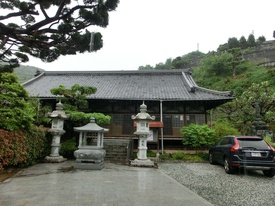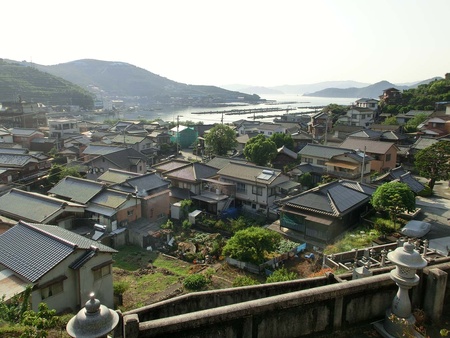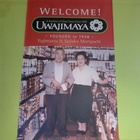Yawatahama City is located in the western part of Ehime Prefecture, Shikoku, facing the Uwa Sea. If you head south on National Route 378, which runs north to south, it eventually turns west and ends up in the small Shitama Bay. From here, the national route curves along the coastline as it continues south.
The calm Uwa Sea can be seen on the right, and on the left are rows of houses, but behind them the road slopes up and gradually expands into fields. This road that runs between the tranquil sea and the mountains seems to have become popular as a cycling road in recent years.
Ehime is known for its mandarin oranges, and farm roads run through the fields up the mountains, with a monorail for transporting the harvested mandarins. The large building is the "Joint Sorting Center" where large quantities of mandarin oranges are collected for shipment. If you look out to the sea, you can see the "traps" of fish ponds everywhere, where sea bream and amberjack are cultivated.
This area was formerly the villages of Kawakami and Mana in Nishiuwa County, a region that sent out many immigrants during the Meiji and Taisho periods, including men who crossed the Pacific Ocean on Utasebune boats. One of these immigrants was Moriguchi Fujimatsu, the founder of Uwajimaya.
Looking out at the ocean and thinking about America?
National Route 378 curves into the mountainside, and there is a settlement called Kawanazu in the former Kawakami village (present-day Kawakamicho, Yawatahama City). If you come from the direction of Shitama, you will enter the settlement by turning off the national route onto a narrow road, and shortly thereafter turning left, you will find Tenmangu Shrine at the top of the hill.
Further back is Gyohan-ji Temple, a Rinzai sect temple. This is the family temple of the Moriguchi family, and nearby is the Moriguchi house where Fujimatsu once lived. The house no longer stands, but Fujimatsu's niece and her husband live in the same place, under the Moriguchi name.
The cemetery of Gyohanji Temple, which has about 300 parishioners, gradually spreads out like a field on the slope behind the temple, with gravestones lined up in rows from top to bottom. The Moriguchi family grave is also located in one area.
If you go up to the top of the cemetery and look back, you can look down at the village of Kawanazu and the sea beyond. If you look from a different angle, you will see the same fields. Many people from the Meiji period onwards probably stood in places like this and looked at the sea, thinking of something.
Utsunomiya Daitaka, the chief priest of Gyohanji Temple, recalls the people who lived in this area in the past.
"I imagine many people looked, wondering what was out there at the end of the ocean. Some were scared, but curiosity was stronger, which is probably why people from this area once crossed the Pacific Ocean in small boats."
In this area, where potato fields were once turned into mandarin orange orchards, mandarin orange cultivation is thriving, and many of the parishioners of Kyohanji Temple are also mandarin orange farmers. However, at the same time, relatives who left this area for faraway America sometimes come to visit the graves.
"Sometimes, third- and fourth-generation Japanese Americans come to pray here," Utsunomiya says.
I want to do big business
However, it seems that it is common for Japanese who immigrated to the United States to lose their connection with Japan as generations pass. I don't know the percentage, but it seems that many people don't know exactly where their roots are, and few people have contact with their relatives in Japan.
Meanwhile, the Moriguchi family, including Fujimatsu's second son and second-generation son Tomio Moriguchi (former president of Uwajimaya), maintains contact with his relatives in Japan. One of them, Tomio's cousin Junko Hasegawa (76), who lives in Matsuyama City, recalls her uncle Fujimatsu as follows:
"From what I've heard, Fujimatsu-san said he wanted to start a big business rather than stay here and be a farmer. But because Fujimatsu-san was the eldest son and ran away, it seems he couldn't stand up to his eldest daughter, Kame-san, who took over the family business."
(Titles omitted)
© Ryusuke Kawai








